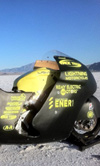Brushless permanent magnet motors
 If we look at the high end of the market as far as racecar alternators are concerned, we see very special productions by only a few manufacturers. Such alternators are chosen for a number of reasons, not least of which is their notable compactness. They are permanent magnet machines, and can be found nestled alongside the engines in Formula One cars. The same technology is used widely in industry and the military, and is also commonly found in various hybrid systems, including those used in racing.
If we look at the high end of the market as far as racecar alternators are concerned, we see very special productions by only a few manufacturers. Such alternators are chosen for a number of reasons, not least of which is their notable compactness. They are permanent magnet machines, and can be found nestled alongside the engines in Formula One cars. The same technology is used widely in industry and the military, and is also commonly found in various hybrid systems, including those used in racing.
Permanent magnet motor technology is more efficient than the more traditional 'brushed' motors, and this can lead to the motors running cooler. They are also quieter, as there is no arcing between the stationary brushes and the rotating motor shaft (commutation arcing). This is true in the acoustic as well as the electrical sense. While we may not notice any noise from an electric motor in a racecar that is also powered by a noisy engine, 'electrical' noise - or electromagnetic interference - can play havoc with adjacent electrical components or systems.
A normal 'brushed' alternator, such as those that we might have seen on our roadcar or motorcycle, will probably have a number of windings carried on the shaft assembly. These windings are connected to different segments of the 'slip ring'. As the segmented slip ring is contacted by the brushes, the coils are energised, creating a magnetic field. These electromagnets are attracted to magnets on the stator, causing the motor to turn. Before the magnets on the stator become aligned with those on the rotor - at which point there would be no turning torque - other coils on the rotor are energised, and so the motor continues in motion.
In a typical brushless motor that we might find in a hybrid system, the wound coils are housed in the stator, and the permanent magnets are on the rotor. By energising the coils in the stator in turn, the shaft is caused to rotate. While the switching of the coils in a brushed motor happens automatically due to the mechanical connection of brush against slip ring, in a permanent magnet motor the switching has to be controlled by other means.

Brushed motors have essentially fixed 'timing', in much the same way as in a distributor and rotor arm, though without any fancy advance mechanism. However, a brushless motor, because it is controlled externally by a computer, can have its 'timing' - that is, the switching on and off of the power to the field coils - changed to suit operating conditions.
Despite the complication added by needing power electronics to allow the rapid switching of electrical power to the stator coils, brushless motors have mechanical advantages over brushed alternatives. Owing to their greater efficiency, they generate less heat, giving an easier time to mechanical components such as bearings. The absence of brushes and slip rings means there is no concern over wear of these components, or their physical breakage.
Fig. 1 - Lightening Motorcycles holds the electric motorcycle land-speed record; its bike uses a permanent magnet motor
Written by Wayne Ward